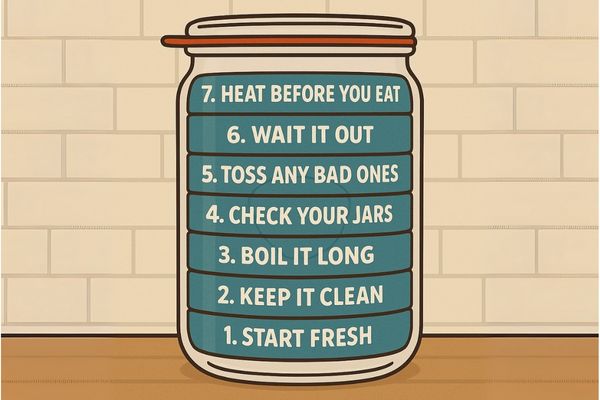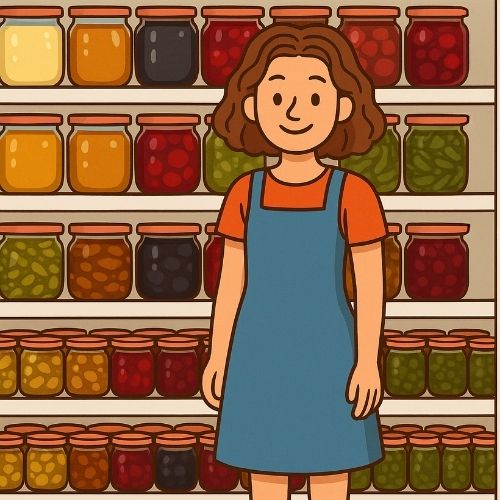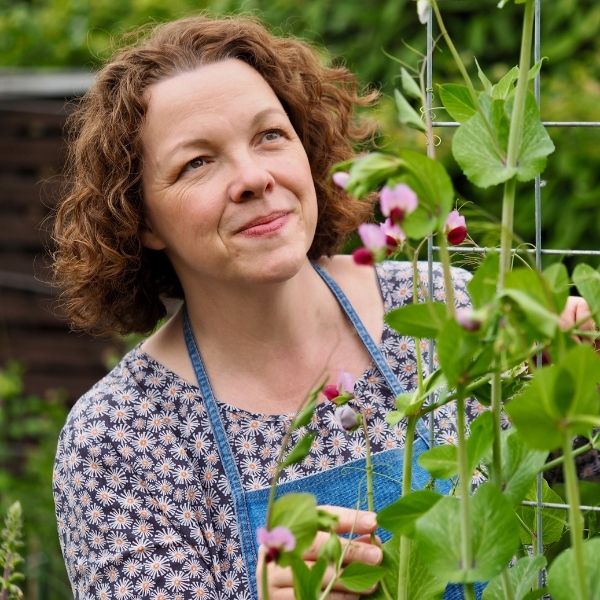If you’re expecting one magic safety step, you’ll be disappointed. But put seven small steps together – and you get a method that works.
Once I understood why Germany and the U.S. developed two very different approaches to home canning, I still had one big question left to answer: could I trust the German canning method? I’d seen people in the forums doing it. I’d read about it. But I needed to know whether this method, which didn’t rely on a pressure canner to process non-acidic foods, could be safe – and why. What I found impressed me.
When I started learning about the German method of water bath canning, I didn’t immediately recognize it as a system. It looked informal from the outside – more tradition than science, more anecdote than evidence. But the deeper I got, especially once I began trying to write about it, the pattern came into focus: this isn’t just a loose collection of habits. It’s a structured, layered approach to food safety. And while it’s not backed by a single government protocol, it functions like one – reliable, reproducible, and surprisingly rigorous.
It’s also additive. This is what makes the German canning method so compelling – it’s not about perfection, but about safety through redundancy. That shift in perspective changed everything for me. What makes this method trustworthy is that multiple layers work together to reduce overall risk. If something isn’t quite right – if a vacuum doesn’t form, or a boiling time was slightly off – other steps like post-canning checks or the waiting period can catch it before anyone gets hurt. That’s how real-world systems work: not by relying on perfection, but by building in safeguards.
Seven layers of safety in the German canning method (as i see them)
These layers aren’t listed like this in any official guide – but when I step back and look at what makes the German method feel safe to me, this is how I see it.

These elements, taken together, are what make the method work:
- Fresh, clean ingredients: It always begins with high-quality, intact, and fresh ingredients – whether fruits, vegetables, or meat. No bruises, rot, or visible spoilage. For root vegetables, the parts that grew underground are peeled and discarded. Everything is washed thoroughly. This upfront care helps reduce the number of spores from the start, which is an important part of keeping the risk low.
- Clean jars and a clean workspace: While it’s not sterile like a lab, the principle is the same: avoid introducing new contaminants. Jars stored in a basement might have traces of mold or mildew on them, so they’re cleaned thoroughly before use. Hands are washed. Work surfaces are wiped down. And we don’t lick the spoon and put it back in the pot – a habit that’s surprisingly hard to break, but part of working cleanly.
- Long boiling times: The times I use come from recommendations shared in German canning forums, not just from the Weck books. I tend to follow the longer versions – not because I don’t trust the method, but because I don’t want to waste my effort canning food that might spoil. Many experienced canners feel the same.
Many sources insist that spores can’t be inactivated without a pressure canner, but that’s just not true. I explain the science behind it in this post: The boiling point myth – why you don’t need a pressure canner to kill Clostridium botulinum spores. C. botulinum spores can be inactivated at boiling temperature. It just takes time. That’s the purpose of these extended boiling times. - Diligent post-canning checks: We inspect every jar after 24 hours, once it has cooled completely and the vacuum has formed. At that point, we remove the clips and store the jars without them. If a vacuum breaks later, we’ll notice it. These checks aren’t because we’re afraid something went wrong – they’re just smart practice. And I’m sure it’s much less disgusting to catch spoilage early than when you’re about to eat what’s inside.
- Immediate disposal of anything spoiled: If we see mold, leakage, bulging, or a bad smell, we throw it out. No exceptions, ever. Period.
- Waiting periods before consumption: Traditional advice recommends waiting a while – anywhere from two to six weeks, depending on who you ask – before eating low-acid foods. This observation period adds another layer of safety. If something went wrong and spores were present, this window gives them time to germinate, start growing, and become obvious. There’s certainly a phase at the beginning where you won’t see any signs of spoilage, but the toxin is already at dangerous levels. It’s extremely potent, so I take this seriously. I’m not sure how many people follow the waiting period, but I do – and it makes me feel more comfortable with the system.
- Reheating before eating: Especially if the waiting period hasn’t passed yet – or if there’s any other reason to have a doubt. Heating inactivates any botulinum toxin that might be present and makes the food safe to eat. If there are visible signs of spoilage, we throw it out – no exceptions. We don’t “heat and eat.” I think that bears repeating.
Each of these practices matters. But it’s their combination that really gives the method its strength. If you’re curious how I put these layers into practice, I explain my full process in this post: How I actually can food at home – base protocol for water bath canning
Trust wasn’t instant. It was earned.
It was scary at first. I come from a culture where botulism is the first thing people think about when they hear ‘home canning’ – and the USDA’s message is so absolute, so categorical, that stepping outside it felt dangerous.
But the more I learned, the more confidence I gained. I haven’t been doing this for decades (yet), but so far, I’ve had no spoilage in my low-acid jars.

What gives me the most reassurance, though, is the community. In the German online canning communities, I’m not relying on one person’s advice – I’m watching hundreds of people ask questions, share experience, and correct misinformation. It’s self-correcting. That’s what ultimately earned my trust.
An informal formal method – refined by a million quiet experiments
At this point, I don’t see the German method as anecdotal at all. I see it as a decentralized protocol, passed down and refined through practice. While Germany’s Federal Institute for Risk Assessment (BfR) does publish official guidance on home canning, there’s no single enforced rulebook. Instead, shared standards and long-tested practices form the backbone of what most people do. No lab-tested checklist – but real-world success built over generations.
After more than a century of use, the absence of significant botulism outbreaks counts for something. The 2025 Weck book (Das Original Einkochbuch) even says: “In over 120 years of WECK history, no case of botulism has become known in connection with canning according to the WECK method.”
This isn’t luck. It’s a layered system – practiced, refined, and trusted for generations, without a single known case. That’s worth paying attention to.
A safe way – even if it’s not their way
I’m not here to convert anyone to German-style water bath canning. But I do want to show why it makes sense – why it works, and why it deserves recognition as a safe, thoughtful method.
I feel safe using this method – because I understand how it works and what each step is designed to do. And I’ve seen it work – not just in my own kitchen, but over and over again in canning forums, videos, and community conversations. The people practicing it take it seriously. They follow clear procedures and treat it like a system. That matters.
Much of what I’ve learned comes from private forums and community exchanges, and I want that knowledge to be easier to find. For anyone new to canning – or curious about how the German method works – I hope this offers not just a how, but a why. Community knowledge shouldn’t stay hidden. It belongs in the public conversation: visible, accessible, and valued. That’s one of the reasons I decided to start this blog on German water bath canning.
I’ve learned there’s more than one safe way to can food at home. This German canning method may not be USDA-approved, but it’s built on layers of practical safety – and it works.
For a broader introduction to the method and why it works, see What you need to know about German water bath canning.

Julie is a biologist turned science writer living in Germany. She shares her passion for traditional German water bath canning, seasonal cooking, and gardening on Old World Preserves.
